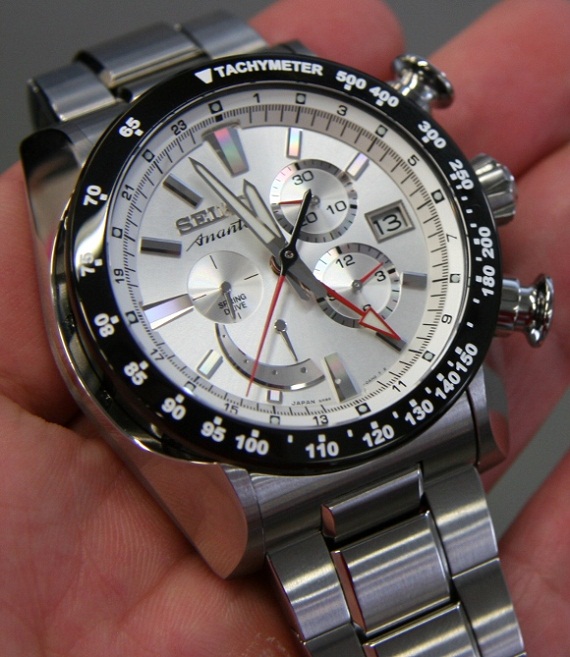The watch dials themselves are beautiful. A lot of this has to do with the large diamond polished hour indexes. You’ll see spots of quality luminant near them on the chapter ring where the numbers for the GMT hand are placed. The hour markers and the hands (also the power reserve indicator strip) reflect light in a wonderful way that give it a prism-like feel. Look closely and you can see little rainbows of colored light gently playing on the surfaces. It is quite impressive. If you’ve never experienced a Spring Drive movement watch, you’ll be impressed with the seconds hand. You know how mechanical watches have a “sweeping” seconds hand, well Spring Drive takes that a step further. I won’t get into a big discussion on this, but on Spring Drive watches, the seconds hand moves in the most perfectly smooth manner you’ll ever see. Seiko calls this “Glide Motion” hands, and it just means they are buttery smooth in their cutting through time.
I could go on and on about the Spring Drive movements – but I will spare you. They are all hand-made and assembled in Japan by highly trained people. The movements are just like mechanical movements, but with a big difference. No escapement. Instead, power is sent directly from the mainspring to the rest of the movement. But there is a catch. The power is regulated by something called a glide wheel the slows down the power moving out of the mainspring. Think of it as a brake. The degree that the power is slowed is regulated by a oscillating quartz crystal. The quartz crystal moves when electrical impulses are applied to it. This electricity is generated right there, from the power moving out of the mainspring barrel. The real trick for the watches was having a long enough power reserve, due to the need of having it generate a small electrical current. It took Seiko almost three decades to make a practical Spring Drive movement. The Spring Drive movements have 72 hours of power reserve on average (closer to 100 hours with the chronograph function activated, opposite of standard mechanical watches).
Each of the Spring Drive Ananta watches have different movements. The chronograph model has a Seiko caliber 5R86, while the GMT has a Seiko caliber 5R66. You can see an image of the 5R86 movements above, as well as a cool diagram with actual parts that I photographed while at the Spring Drive manufacture in Japan (click on that image to make it larger). Seiko Spring Drive movements are accurate to within about 1 second a day (which is pretty much equivalent to quartz movement based watches). So with a Spring Drive movement based watch, you really have all the things you love about mechanical watches with the accuracy of a quartz movement. Oh, and just to be clear, the mainspring is powered by both the automatic rotor or hand-winding via the large crown. In all ways, these movements are top notch from construction to performance. Really the apex of what Seiko is known for.
Hard to think of complaints about the watches. I would have liked for there to be a Seiko signature or logo on the crown, but that is a minor point. Also, the GMT hand is kind of strange to adjust until you get the hang of it. It is totally independently adjustable (thankfully in one hour increments), but the process of doing so is different than in Swiss movements. Otherwise the watches are hard to beat. Even though they are pricey, they are an incredibly good value in comparison to European watches. Retail prices for the Seiko Ananta Spring Drive watches range from about $5,500 – $8,100. Certainly worth looking at if you are a Seiko fan, or just like the looks. Plus, if you are looking for a quality timepiece with GMT and chronograph functionality, these watches are hard to beat. Forgot what you think Seiko watches are if you simply think they are reliable inexpensive watch. There are plenty of Seiko watches that fit into that category, and there is also this new world high-end Seiko watches that you’ll soon become more and more familiar with.
Visit the Seiko Ananta website to learn more or find a store.
